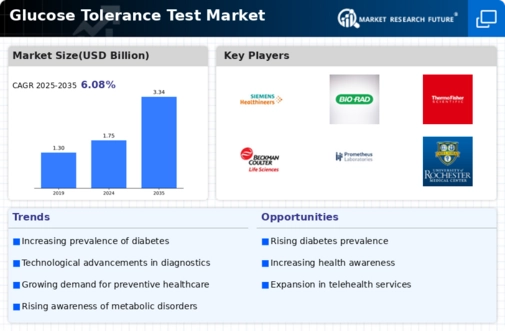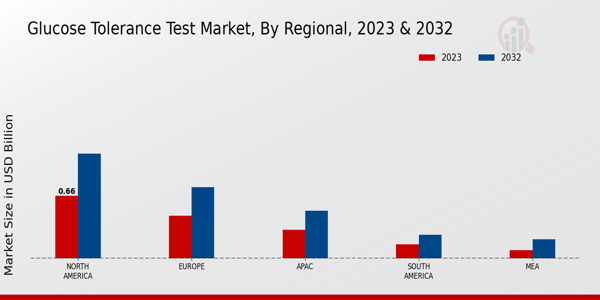Market Growth Projections
The Global Glucose Tolerance Test Market Industry is projected to experience substantial growth over the next decade. With a market value expected to reach 1.75 USD Billion in 2024 and 3.34 USD Billion by 2035, the industry is poised for a robust expansion. The anticipated compound annual growth rate (CAGR) of 6.06% from 2025 to 2035 indicates a strong demand for glucose tolerance testing as healthcare systems worldwide prioritize diabetes management. This growth trajectory reflects the increasing recognition of the importance of early detection and intervention in diabetes care.
Increasing Health Awareness
The growing awareness of health and wellness among the global population is significantly influencing the Global Glucose Tolerance Test Market Industry. As individuals become more informed about the risks associated with diabetes, there is a corresponding increase in demand for preventive health measures, including glucose tolerance testing. Educational campaigns and community health programs are playing a crucial role in promoting the importance of early detection. This heightened awareness is likely to drive market growth, as more people seek testing services to monitor their glucose levels and manage their health proactively.
Rising Geriatric Population
The aging population worldwide is a critical factor contributing to the growth of the Global Glucose Tolerance Test Market Industry. Older adults are at a higher risk of developing diabetes, necessitating regular screening and monitoring. As the global demographic shifts towards an older age structure, healthcare systems are increasingly focusing on diabetes prevention and management strategies tailored for this population. The demand for glucose tolerance tests is expected to rise in tandem with the geriatric population, further propelling market growth. This trend highlights the need for healthcare providers to adapt their services to meet the unique needs of older patients.
Rising Prevalence of Diabetes
The increasing incidence of diabetes globally drives the Global Glucose Tolerance Test Market Industry. According to health statistics, the number of individuals diagnosed with diabetes continues to rise, with projections indicating that by 2035, approximately 700 million people could be affected. This surge necessitates effective screening methods, such as glucose tolerance tests, to identify at-risk populations. As healthcare systems worldwide prioritize early detection and management of diabetes, the demand for glucose tolerance testing is expected to grow, contributing to the market's expansion. The market is projected to reach 1.75 USD Billion in 2024, reflecting the urgent need for diabetes management solutions.
Advancements in Diagnostic Technologies
Technological innovations in diagnostic tools are enhancing the accuracy and efficiency of glucose tolerance tests, thereby propelling the Global Glucose Tolerance Test Market Industry. Newer methodologies, such as continuous glucose monitoring and automated testing systems, are being integrated into clinical practices. These advancements not only improve patient outcomes but also streamline testing processes, making them more accessible. As healthcare providers adopt these technologies, the market is likely to experience significant growth. The anticipated market value of 3.34 USD Billion by 2035 underscores the potential impact of these innovations on diabetes screening and management.
Government Initiatives and Health Policies
Government initiatives aimed at combating diabetes and promoting preventive healthcare are pivotal in shaping the Global Glucose Tolerance Test Market Industry. Many countries are implementing policies that encourage regular screening for diabetes, particularly in high-risk populations. These initiatives often include funding for public health campaigns and subsidized testing services. Such measures not only raise awareness about diabetes but also facilitate access to glucose tolerance tests. As a result, the market is expected to grow at a CAGR of 6.06% from 2025 to 2035, reflecting the positive influence of government support on diabetes management strategies.


















